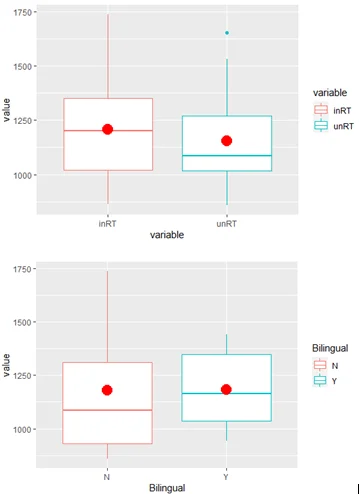Problem Description
The Data Analysis assignment involves analyzing reaction times (RT) in the context of linguistic prefixes and bilingualism. Specifically, it explores the mean RTs for different prefixes and compares the RTs between bilingual and monolingual participants. Additionally, it examines the correlation between students' ability to speak Irish and their perception of their abilities over time.
Question 1:Prefix Comparison
- Mean RT for words with 'in-' prefix:1206.46 (Standard deviation: 240.0684)
- Mean RT for words with 'un-' prefix: 1152.985 (Standard deviation: 221.5581)
Question 2:Bilingual vs. Monolingual Comparison
- Mean RT for bilinguals: 1192.594 (Standard deviation: 225.8611)
- Mean RT for monolinguals:1166.851 (Standard deviation: 238.4756)
Question 3: Visualization

Fig 1:Visualization of the mean values of the variables
- In the visualizations, the red points represent the mean values of the variables.
Question 4:Statistical Tests
- To compare mean RTs for bilingual and monolingual participants, we used an unpaired two-sample t-test.
- To compare RTs for 'in-' and 'un-' prefixes, we used a paired sample t-test.
Question 5:Test Results
- Monolinguals vs. Bilinguals: t(27.432) = -0.04296, p = 0.966. Therefore, the difference between means is not statistically significant. The effect size is negligible.
- 'In-' vs. 'un-' prefixes: t(17) = 3.1764, p = 0.0055. Therefore, the difference between means is statistically significant. The effect size is small.
Question 6: Conclusion
- From the analysis, it can be concluded that, regarding the monolingual and bilingual variables, there is no significant difference in reaction time. However, there is a statistical difference in reaction time between the 'in-' and 'un-' prefixes.
Question 5B: Longitudinal Study Q1:
- The relationship between students' abilities to speak Irish and their perception of their abilities at Time 2 appears to be approximately positively correlated. This suggests that as students' abilities remained unchanged from Time 1 to Time 2, their perception of their abilities decreased, indicating that they now perceive themselves to be more skilled in speaking Irish.
Q2:
- Using a paired samples t-test is a suitable approach for longitudinal studies, especially when analyzing data with repeated measurements from the same participants. It allows for the comparison of data over time while accounting for individual variations.
By presenting the assignment solution in this structured manner, it becomes more accessible and visually appealing for your website visitors, making it easier for them to understand the problem, analysis, and conclusions drawn from the data.
Similar Samples
Discover a diverse array of exemplary assignments exemplifying the expertise of www.statisticsassignmenthelp.com. Navigate through our sample section for a comprehensive insight into the caliber and precision of statistical solutions provided. Each sample meticulously curated to showcase proficiency and lucidity in statistical analysis. Experience firsthand the excellence awaiting you in the realm of statistical assistance.
Data Analysis
Data Analysis
Data Analysis
Data Analysis
Statistics
Data Analysis
tableau
Data Analysis
Data Analysis
Data Analysis
Data Analysis
Data Analysis
Data Analysis
R Programming
Data Analysis
Data Analysis
Data Analysis
Data Analysis
Data Analysis
Data Analysis
